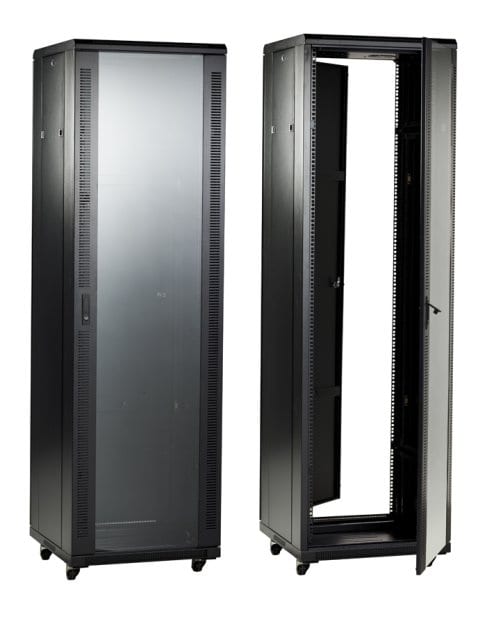Bud’s versatile BRP 19″ Cabinet Rack
It is often said that buying an electronic enclosure is technologically simple. Just know your required dimensions and materials and your selection becomes only a matter of style. However, for many, navigating the terms and abbreviations can make this a much more challenging process, so here is a guide to some of the more commonly used terms and a brief definition to help make you an electronic enclosure expert.

A Large Electronic Enclosure is typically selected based on Panel Space
First, I will start with some general enclosure terms, then ratings and finally the rating agencies.
1. “U”. A unit of measure that equals 1.75”.
It is normally used as the unit of measure to determine the size of the open vertical space on an electronic enclosure. So a 42 u cabinet has an open vertical space of 73.5” (42 x 1.75”). It also denotes the hole pattern, known as EIA spacing, on the rails for mounting equipment. This hole pattern is 5/8”, 5/8”, ½ “, again totaling 1.75”
2. “Panel Space”
This is the clear vertical opening in a cabinet or rack. As noted above, it is typically measured in increments of 1.75”
3. “Panel Width”
This is the horizontal dimension of the open mounting space. In most cabinets and racks, this is 19” or rarely 23”
4. “Overall Height”
This is the actual height of the cabinet. With the focus on the panel height used for mounting equipment, the overall height can be overlooked creating problems for installation including products that are taller than the room or entry door.
5. “Clear inside width or depth”
This is the space that is available within the cabinet, on a horizontal plane, for the mounting of equipment.
6. “PMR”
This is the abbreviation of Panel Mounting Rail of which there are at least 2 and sometimes as many as 6 in a cabinet to allow for the mounting of equipment within the electronic enclosure. These are mounted vertically and have holes that are drilled on the EIA spacing standards mentioned above
7. “IP”
This is the abbreviation of “Ingress Protection” which is a rating system that determines the level of protection provided by an enclosure, focused on both liquids and solid objects. As the name suggests, this is most popular outside of the United States, but is gaining acceptance here as well.
8. “NEMA”
National Electrical Manufacturers Association. In terms of enclosures, their rating system, also denoting the level of production for box or other product, focuses on liquids, dust, and weather and is mostly used in the United States.
9. “UL”
The Underwriter’s Lab establishes and performs tests for NEMA ratings and is considered the most reliable confirmation of the enclosures protection level.
10. “TUV”
Technischer Überwachungsverein (Technical Inspection Association) is the German based organization that is most frequently used to confirm IP ratings.
No list of terms is ever exhaustive, so let me know if there are others that you think are important for me to define or should be included on this list.


